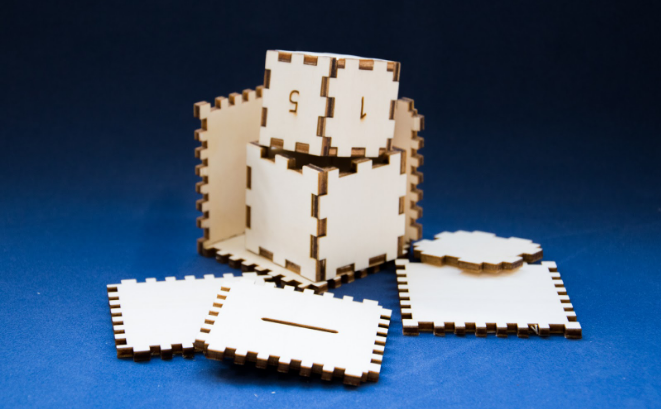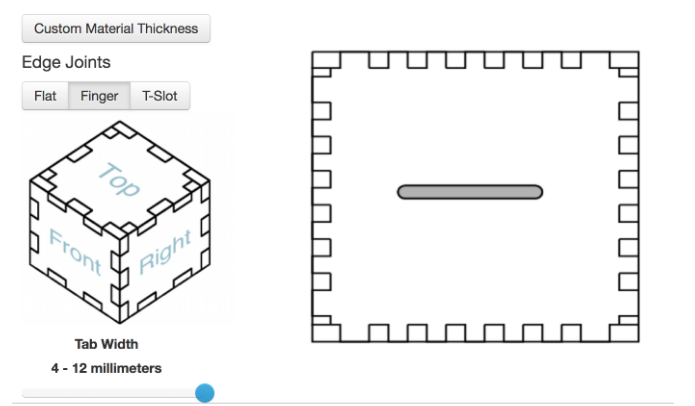Box in the Box: Design for Lasercut With Makercase
by Digijeunes in Workshop > CNC
5564 Views, 7 Favorites, 0 Comments
Box in the Box: Design for Lasercut With Makercase

In this activity you will learn how to design boxes and cases via the on-line design software available at makercase.com
Objectives
- Design perfectly nested boxes using the free online tool Makercase.
- Learning goals for this activity are:
- Comprehend how to measure and set dimensions Learn to design compound shapes Learn how to create a 3D object from 2D shapes Learn the basics of designing for laser cutting Master the basics of Makercase (an on-line tool for 3D designing boxes)
Designing the Cube
- Set the units to millimeters
- Set the dimension as EXTERNAL and set the size as 40 width, 40 height, 40 depth
- Set the material thickness: we suggest using 4mm using the “Custom material thickness” option
- Select the Finger mode for the Edge Joints option
- Set the tab width to 4 mm
Adding the Numbers to the Cube
We are going to create a dice just using Makercase
- Double click on the faces to add text
- Write the number from 1 to 6 one on each face
[Tip: To create a correct regular dice the sum of opposite faces should be 7: 1 opposite to 6, 5 opposite to 2, 4 opposite of 3]
Generate Laser Cutter Case Plans
Vector cutting: you can set the thickness and the color for the cutting lines (we use thickness 0,01 mm and color blue #0000FF)
[Tip: we suggest you to set the line thickness at the end, because very thin lines can be difficult to visualize]
Text engraving: set the color to the desired color for raster engraving. We use #808080 Check “Convert Text to Vector Paths”
Laser cutting kerf: 0.1
The Laser cutting kerf
This is the most important setting and is the also one of the concept this activity aims to explain.
“Kerf” is the material that the laser burns away while cutting. It depends from laser source wattage, the lenses used for the laser, the kind of material and its thickness.
We suggest to set 0,1 mm. From our tests in fact we noticed that a general value, common to most lasers and various material, is 0,2 mm.
We suggest to use “soft” materials, as poplar plywood. Acrylic/plexiglas will be difficult to join, and MDF or hard woods can require some pressure on the slots to be joined.
If you wish to expand the concept of laser cutting kerf, tolerances, going from 2D to 3D, you can experiment using different slight different settings to create boxes: 0,9, 1, 1,2 mm… the students can have an experience on how a small change in value can create different effects when working with interlocking parts.
- Download plans: you will obtain a file ready for laser cutting.
Understanding the Importance of Sizes
Aim of this step is to create a box that contains the dice, with a perfect fit that won’t let the dice move but that is not to tight because the dice needs to be removed easily.
Students must think about the size and dimensions of the dice just created. Since the side measures 4 cm, we cannot create a container that has an internal size of 4 cm, as the dice will be constrained into it. We need to create a container that is slightly larger.
- Set the dimension as INTERNAL and set the size as 42 width, 42 height, 42 depth
- Set the material thickness: we suggest using 4mm using the “Custom material thickness” option
- Select the Finger mode for the Edge Joints option
- Set the tab width to 8 mm
Changing the tab width changes the results of the box. A higher number of narrow tabs makes the box really difficult to open, while wider tabs make it easy to open if needed.
- Click on Generate Laser cutter Case Plans and follow the same settings of the previous step.
- Set the kerf to 0,08 mm. This will make the box easy to open to access the dice
- Download plans.
Designing a Useful Box

We will design a final box that will also work as a small piggy bank.
- Set the dimension as INTERNAL and set the size as 60 width, 60 height, 60 depth
- Set the material thickness: we suggest using 4mm using the “Custom material thickness” option
- Select the Finger mode for the Edge Joints option
- Set the tab width to 12 mm
- Double click on the top face and choose the option rectangular holes
We need to create a slot that is wide enough for a large coin (e.g. the 2 €).
- Choose a large coin and measure its diameter and thickness
- Set the dimension size of the slot in order to have it larger, for example 2 € coin has a diameter of 25,75 mm, we suggest to set the width of the box to 30 mm.
- Set the height of the slot in order to have it a little bit more thick than the actual thickness of the coin. 2 € has a thickness of 2,20 mm. We suggest to use 3mm.
- Set the radius corner to 2
Centering the position of the slot
The default position values is referred to the center. Students need to calculate the starting position of the slot from the center. This can be done doing X preset position - (slot width / 2). And again Y preset position - (slot height / 2)
If you followed our suggested dimension, the center of the slot will be in X=18 Y=31.5
- Click Add
- Click “Done” on the left bar menu
- Click on Generate Laser cutter Case Plans and follow the same settings of the previous steps.
- Set the kerf to 0.09 mm. This will make the box easier than the dice to open, but not so easy!
- Download plans.
Laser Cut and Assemble the Boxes
Follow-up to the Activity
Tutor can ask the students their feedback on the ability to interlock 2-dimensional parts with different ease.
Students can design further cases that can be used as simple boxes, special containers, pen holders and so on.